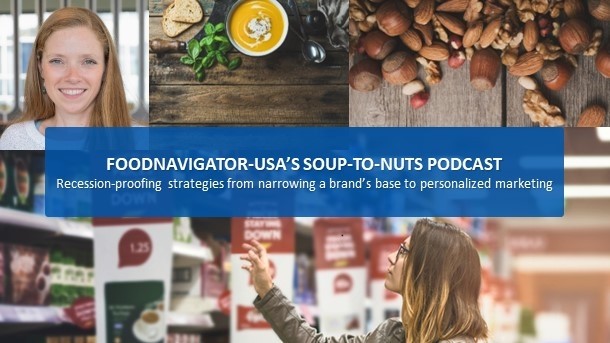Soup-To-Nuts Podcast: Recession-proofing strategies from narrowing a brand’s target audience to personalizing marketing

According to research published last week by FMI – The Food Industry Association, 61% of US shoppers are concerned about rising food prices, which according to the most recent consumer price index published Oct. 13 were up 13% for food consumed at home in September over the previous year. Of these consumers, FMI found 30% are changing which brands they buy – up 5 percentage points from August – and 44% are buying more store brands, up 3 percentage points from August.
Unlikely to slow or reverse any time soon with increased expenses of the holidays upon us and the threat of a recession and layoffs on the horizon, brands and retailers across the industry are scrambling to attract and retain consumers – prompting some players to reengage their advertising, marketing and promotional efforts that they pulled back on early in the pandemic, while others are exploring more dramatic rebrands to appeal to new consumer priorities and shopping habits that emerged in the past three years.
But given many companies are under the same financial pressures as consumers, Jason Byer, a marketing manager at Crowdspring, says, their efforts must be concentrated, cost-effective, and uniquely compelling in order to be effective. To do this, he explains in this episode of FoodNavigator-USA’s Soup-To-Nuts podcast, businesses must first identify (or reidentify) their core consumer, who may be different now than pre-pandemic, and then ensure that their branding clearly targets and connects with them at each phase of the shopping experience – from discovery through unboxing and use. He also explores how companies can recession-proof their business by using personalizing marketing at scale to drive loyalty, and when and how to expand or contract their portfolio to withstand turbulent markets phases, such as a downturn.
[Editor’s note: Never miss an episode of FoodNavigator-USA’s Soup-To-Nuts podcast – subscribe today.]
Tightening a brand’s target consumer can avoid ‘waste’ during a downturn
The chaos of the past few years has created a unique opportunity for consumers and brands that may not have previously connected to do so – which might inspire some companies to go all-in to attract new shoppers, but Byer says they need to be strategic in who they pursue in order to avoid “waste” at a time when margins are tight and the economy unpredictable.
“What pandemics and recessions do is they break our habits. And so, before … you might have only shopped one brand and it might have been one of the larger brands, there’s opportunities for newer brands to come in and challenge that space,” Byer said.
But, he added, “when you talk about pandemics and recessions, you [also] want to tighten up those budgets in marketing,” which means knowing exactly who to target and the best way to reach them.
To do this, Byer recommends companies carefully consider not just who is buying their product, but who isn’t and then targeting communication only to those shoppers who will respond to it.
“This will take a lot of stress off yourself because you know who you’re trying to target and you’re ignoring the people you’re not trying to target. So that waste is only happening within the confines of this audience,” which allows you to save money, he explained.
Balance tight brand communication with a broader portfolio
Byer acknowledges that narrowing who a brand or product targets may sound counterintuitive to some businesses – especially new ones that want to build up their base and sell as much product as possible.
But, he explains, it is easier to have a conversation and create a connection “with a very specific person than to say we target an entire generation of people.”
He adds that a more strategic way to reach more shoppers – and potentially help recession-proof the company – is to expand the larger portfolio so that individual brands or products remain tailored for certain segments but each of those segments are distinct enough so as to broaden the company’s overall reach.
He explains large CPG companies often do this by acquiring or launching brands that complement their existing portfolio – so for example a premium coffee brand to appeal to more affluent consumers to complement a more accessible brand with a lower price point.
He cautions, however, adding new brands should only happen after either perfecting the first or learning from its shortcomings.
A possible exception to this rule might be if there is a dramatic shift in the market – such as a recession – and a business needs to quickly pivot to stay afloat. But even then, Byer said, companies need to honestly assess if their brands or portfolio’s are recession-proof or not before making any moves.
Leverage brand identity to connect with consumers, standout from the competition
Once a business accurately matches a brand to a consumer, Byer says the need to ensure that brand and their brand identities accurately and effectively communicate that connection and that they are distinct from the competition.
“What we find is that a lot of us, when we start a business are just anxious to start offering the product and anxious to start getting feedback,” and so the “early branding is often very chaotic. Our visuals are chaotic, the messaging is chaotic, who we’re talking to is unclear,” he said.
And while companies can get away with that for a little while, after a few years they need to start assessing patterns and teasing out who their shopper is and create branding that appeals to them – or else risk sales plateauing or declining.
Strategies to personalize marketing at scale
Just as essential as personalizing a brand’s identity is personalizing marketing to appeal to consumers, who increasingly want bespoke products, even if they don’t want to pay bespoke prices.
Byer explains there are several strategies for scaling ‘personalization’ that don’t break the bank.
For example, The Coca-Cola Co’s campaign a few years ago to include consumer’s names on bottles was wildly successful because shoppers felt seen when they found their name – but in reality the company only used a set amount of popular names to keep packaging costs in check.
A company with a smaller budget can recreate this effect – sometimes more effectively – by including a note or space on the label where they can fill in the consumers’ name for a relatively small cost.
Byer explains that personalization isn’t limited to packaging – companies can also deliver a unique experience through the unboxing of a product, which can range from purely functional to including added touches that surprise and delight consumers so they keep coming back.
Crowdspring’s marketplace model simplifies branding
Successfully pulling off personalization without losing the brand’s identity can be challenge – as can creating branding identities that accurately represent a company, appeal to consumers, standout on shelf and come in under budget.
But this is where Byer says Crowdspring really shines.
“We’re not an agency. You pay a flat rate with a 100% money back guarantee to get dozens of different custom designs back and you can give unlimited feedback to these designers and iterations” so you end up with something highly personalized but not highly expensive, he said.
Byer also notes that the branding process doesn’t need to be overwhelming because it doesn’t need to be done all at once. For example, he said, companies can start with a custom illustration project that tackles smaller elements of branding than the front-of-panel packaging, such as the directions for how to use a product or the story behind its inspiration. This allows a company to test different styles safely.
“The branding process takes time. It takes a lot of questions. It takes a lot of iterations and testing… but there are a lot of ways where we can just starting having conversations with customers, start to understand who they are and start to make little changes,” he said.
If this still sounds overwhelming to you, don’t worry you are not alone. Which is why Byer said Crowdspring often starts with a brand identity review that includes actionable feedback and strategies for improving sales and which is completely free. To learn more about this, Byer says, companies simply need to visit crowdspring.com.











